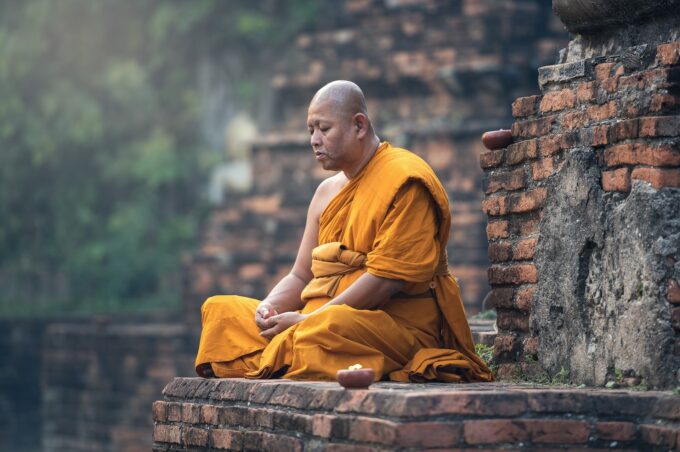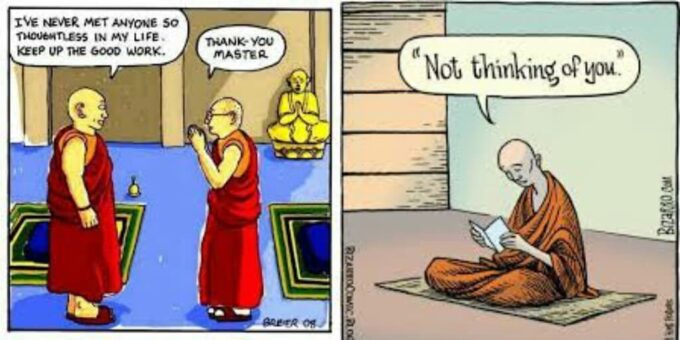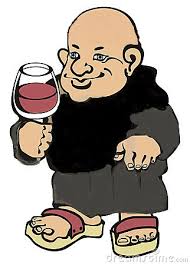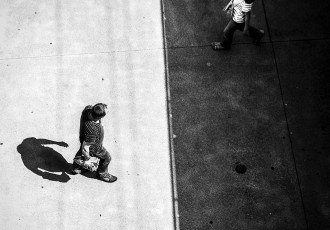*Words by Sava Chankov (originally written on Quora)
I spent the last year in a Zen temple in the Hungarian capital of Budapest.
Before you read on I would like to note that Buddhism has many branches and one’s experience might differ quite a bit. Our lineage, Mokusho Zen, which stems from Master Deshimaru, who brought Zen from Japan to Western Europe, and his disciple Master Zeisler, who brought it to Eastern Europe, is notable that monks do not quit secular life and do not take vow of celibacy. Monks are only obliged to do three things: to shave their heads, to practice Zazen (that is seated Zen) every day and to attend all sesshins (periods of extended Zazen practice). Outside of that, they’re free to pursuit a lifestyle that suites them best.
Let’s start with the most important: the main reason to live in a temple is to follow the Way. If your motivation is to sort out a problem or hide from life in society I’d recommend against it: you’ll probably get bored and soon leave to escape from your problems in a different place. But if instead of simple curiosity you are driven by a genuine spiritual need, I can hardly imagine a better place to be.
Photo: Sava Chankov
This is not a picture of the temple I lived in, but of the mountain temple where we spend only a few weeks every year. I couldn’t resist posting it as it features everything one would expect of a Zen temple, including mystical haze just in front of the building (actually smoke from disintegrated cardboard boxes we burned at the end of a practice retreat).
So how on Earth I got there? In 2016 I found myself travelling every other month to Budapest to attend sesshins (usually 10 days long in our lineage). Even though I like traveling a lot I found it a little bit exhausting and considered moving to Budapest so that I don’t have to spend so much time on the bus, in the train, hitch-hiking or cycling between Bulgaria and Hungary (until the end of 2016 there were no cheap flights from Sofia to Budapest). At the end of 2016, two of the then current residents of the temple were moving out as they bought a house nearby. I took the opportunity and in January 2017 I moved in.
The Budapest temple of our lineage is an old house with a big garden in the suburbs. On the ground floor, which is half sub terrain, are the kitchen, bathroom, changing room and storage. On the first floor is the dojo (the practice hall; in other Zen lineages it is called zendo), the monks’ bedroom and the office. In the loft below the roof lives Master Myoken.
Photo: Sava Chankov
No, Master Myoken doesn’t have a beard like this artist rendering on the wall of his flat. In fact, his head and face are cleanly shaved as is customary in the Zen tradition
The only resident except me was one of the disciples of the Master, who had received Dharma transmission (shiho) in the previous year and was regularly travelling to other dojos, so about half of the time I was the single constant resident. As ours is an urban temple, the Sangha (the community of practitioners) comes to practice twice a day, in the morning and in the evening, some of them staying overnight sometimes, so there is a constant influx of people and I rarely felt lonely.
My daily routine started around 5:15 when I woke up, folded my bed – I was sleeping on a mattress on the floor – and after refreshing myself I put my kimono and rakuso (a small sacred garment that one receives on entering a Zen lineage), lighted an incense stick and put it on the altar, and rang the morning bell at 5:30 to wake up everyone still asleep.
Photo: Sava Chankov
The altar with the morning bell to the left of it. To the right is the little bell (inkin) which is used to announce Master’s arrival in the dojo and signal during the ceremonies. In the upper left is the wood (han) that is beaten with the little wooden hammer 15 minutes before start of the practice as well as at the end of the zazen before the ceremony. Above the altar is a picture of Master Zeisler holding a samurai sword. The sword in the Buddhist tradition symbolizes awekening which cuts all the illusions.
The morning practice of Zazen starts at 6:00 and ends with a short ceremony of three prostrations (sanpai) and chanting the Heart Sutra in Japanese (Hannya Shingyo) accompanied by a bell and a wooden drum (mokugyo) around 7:30. It is followed by a thorough cleaning practice (soji) and then oryoki practice in the dojo (eating together in a ritual manner). The breakfast in our lineage consists invariably of rice-and-vegetables porridge (guenmai). You’re served tea in the same bowl you eat in order to clean it. Before drinking you pour a bit of your tea in a bowl for the hungry ghosts (gaki). After the breakfast is finished we go out to the garden alter where the Master sprinkles the gaki water at us. This marks the end of the morning practice.
During the day I used to do my usual job – I am a partner in a small software company and I work remotely. There was another monk also working remotely and we were sharing the office. At lunchtime I prepared the meal for the Master – people in the Sangha took turns to cook, I just warmed up the meal and made some salad – and we had a lunch in his loft with him and whoever was in the temple. During lunch we were watching a movie: the choice ranging from new wave Romanian art cinema to Hollywood blockbusters. It took a few days to finish a film as we were watching piecemeal. In the afternoon I continued my work and did the usual maintenance chores (cleaning, washing, etc). The evening practice started at 18:30 and ended around 20h, followed by a short supper at Master’s loft. Soon after we went to bed, I rarely stayed awake after 22h.
Photo: Sava Chankov
Sunday was free of practice. I usually hiked the mountains around Budapest or went to one of their many public mineral baths.
Photo: Sava Chankov
Life in a temple nurtures a specific silence within. You start to notice little things that you normally don’t pay attention to in the course of everyday life: water drops on the windows after rain, the slow yellowing of the leaves at the end of the summer and beginning of autumn and so on. The non-judgemental communication with other practitioners re-builds the inner peace to the point that when I was back to the everyday life I felt a bit overwhelmed by the way people behave towards each other.
Photo: Sava Chankov
In September my colleagues visited Budapest for a technical conference and we went out for an evening. In the past, I was avid partygoer but now I was a bit shocked by the loads of people who were wasting themselves on alcohol and drugs. On the night bus back I felt painful compassion as I watched all the drunken people with empty eyes balancing clumsily while clamping to the supporting rails.
Photo: Sava Chankov
During my stay temple walls and ceilings murals were painted by a gifted artist who is a member of the Sangha:
Photo: Sava Chankov
Myokai, the Boddhisatva of painting and singing, between oryoki sets shelf on the left and gaki mural he just finished on the right. On the top left of the shelf jarlets of gomasio (sesame crushed with salt: the only seasoning available during meals in the dojo) are visible.
Photo: Sava Chankov
Master Keisen Vuillemin, who is one of the Dharma successors of Master Myoken, is a retired experimental physicist. He worked at CERN when Tim Berners-Lee invented the web there in 1989.
Photo: Sava Chankov
The Bucharest dojo of our lineage is a small building hidden between 10–15 storey brutalist blocks of flats erected during the socialist era that are ubiquitous in Eastern Europe.
Photo: Sava Chankov
View from the top of the watchtower on the hill nearby the temple. The temple roof is visible – it is one of the houses in the background.
This traditionally looking lantern (actually made of concrete) stands in the mountain temple close to Budapest which is open only during summer and winter Ango. In our lineage, the summer Ango is a month and a half period of secluded practice, the winter Ango – a week-long sesshin between Christmas and New Year.
If you would like to practice Zazen or attend a sesshin in Budapest, you can find details at mokushozen.hu, in Romania at mokushozen.ro, and in Bulgaria at mokushozen.bg.




